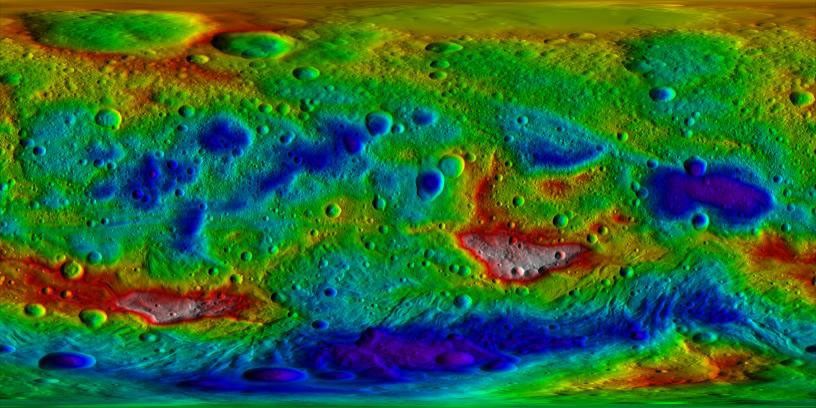Dawn at Vesta
Vesta was discovered on March 29, 1807 by astronomer Heinrich Wilhelm Olbers, and is named after the virgin goddess of home and hearth from Roman mythology. About twice the area of California, Vesta is the second largest object in the asteroid belt after the dwarf planet Ceres.
Vesta has many unique surface features which intrigue scientists. Dawn found two colossal impact basins in Vesta’s southern hemisphere—the 310 mile (500 km) wide Rheasilvia basin, and the older 250 mi (400 km) wide Veneneia crater. The combined scar created by these two impacts was apparent even in Hubble Space Telescope images, which also discerned a peak in the center. Dawn’s data showed Rheasilvia’s width is 95% of the mean diameter of Vesta and it is about 12 miles deep. Its central peak rises 12-16 miles and is more than 100 miles wide, making it compete with Mars' Olympus Mons as the largest mountain the in solar system.
What happened to the one percent of Vesta that was propelled from its home during those impacts? The debris, ranging in size from sand and gravel to boulder and smaller asteroids (known as Vestoids), was ejected into space where it began its own journey through the solar system. Scientist believe that about 6 percent of all meteorites we find on Earth are a result of this ancient impact in deep space.
Accomplishments at Vesta
Dawn mapped Vesta's geology, composition, cratering record and more. It determined Vesta's interior structure by measuring its gravity field. Together, this data has elucidated the formation and evolution of this small rocky world in the main asteroid belt. Dawn found a heavily cratered surface on Vesta, with a rough topography that is transitional between planets and asteroids. In addition to creating an enormous hole at Vesta’s south pole, the two giant impacts caused planet-encircling trough systems to form.
The Dawn mission confirmed that Vesta is the parent body of the howardite-eucrite-diogenite (HED) meteorites, via confident matches between lab-based measurements of HEDs and Dawn's measurements of the elemental composition of Vesta’s surface and its specific mineralogy. Dawn also found that Vesta's gravity field is consistent with the presence of an iron core around 140 miles in diameter, in agreement with the size predicted by HED-based differentiation models. Together, these results confirm that Vesta experienced pervasive, perhaps even global melting, implying that differentiation may be a common history for large planetesimals that condensed before short-lived heat-producing radioactive elements had decayed away.
Surprisingly, pitted terrains and gullies were found in several young craters, interpreted as evidence of volatile releases and transient water flow. Vesta's composition is volatile-depleted, so these hydrated materials are likely exogenic.
More About Vesta
› Vesta's Greatest Hits (video)
Mission Events
Sept. 27, 2007: Launch
Feb. 17, 2009: Mars Gravity Assist
July 16, 2011: Vesta Arrival
Sept. 5, 2017: Vesta Departure
March 5, 2015: Ceres Arrival
June 2016: End of prime mission
July 2016: Start of first extended mission
October 2017: Start of second extended mission
Nov. 1, 2018: End of Mission
































